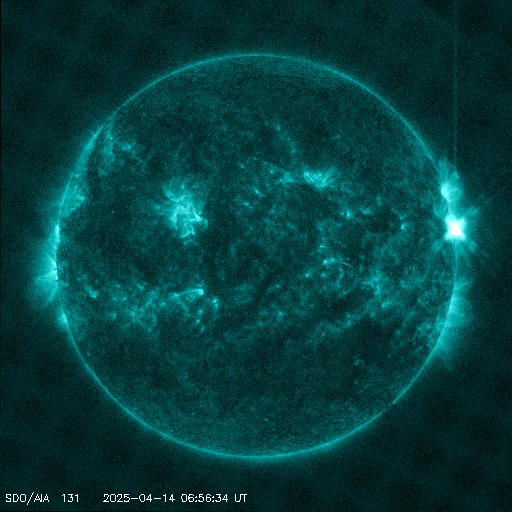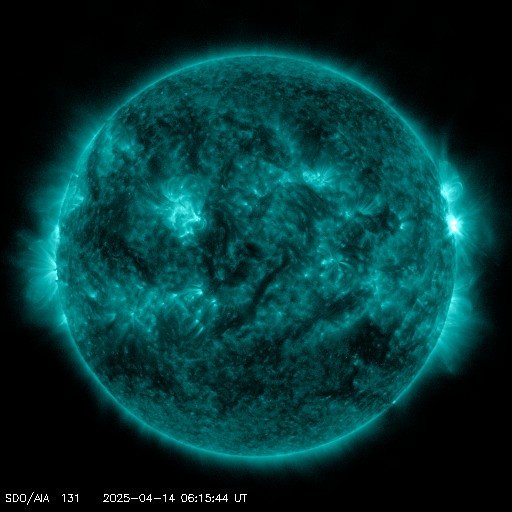Viewing archive of Wednesday, 26 February 2014
Daily bulletin on solar and geomagnetic activity from the SIDC
Issued: 2014 Feb 26 1319 UTC
SIDC Forecast
Solar flares
Active (M-class flares expected, probability >=50%)
Geomagnetism
Active conditions expected (A>=20 or K=4)
Solar protons
Proton event in progress (>10 MeV)
| 10cm flux | Ap | |
|---|---|---|
| 26 Feb 2014 | 176 | 007 |
| 27 Feb 2014 | 178 | 028 |
| 28 Feb 2014 | 178 | 025 |
Bulletin
Solar activity has calmed down since the X-class firework of yesterday. Flaring activity in the past 24 hours has been at the C5 level in active regions NOAA1986-Cat48 and NOAA1989-Cat50. For the first region, the activity corresponds to a (recurrently) activating filament which we expect to erupt at some stage. Major (M or X class flaring) flaring potential remains in various active regions, in particular NOAA1982-46, NOAA1987-Cat54 and NOAA1990-Cat52. The CME associated with the X4.9 flare of Feb 25 00:49 expanded to a full halo CME. Propagation speeds above 1500 km/s were measured. Culgoora Observatory observed type II radio bursts with speeds of 2000 km/s and 700 km/s. As this CME was not completely Earth-directed, we expect that only a glancing blow of the shock will arrive at the Earth, early Feb 27. Soon thereafter (Feb 28 late onwards) we also expect the influence of the fast wind stream from a small coronal hole that crossed central meridian mid Feb 24. As a consequence, we expect episodes of active geomagnetic conditions from early Feb 27 onwards for about 48 hours.
Today's estimated international sunspot number (ISN): 141, based on 09 stations.Solar indices for 25 Feb 2014
| Wolf number Catania | /// |
| 10cm solar flux | 174 |
| AK Chambon La Forêt | 010 |
| AK Wingst | 003 |
| Estimated Ap | 004 |
| Estimated international sunspot number | 125 - Based on 15 stations |
Noticeable events summary
| Day | Begin | Max | End | Loc | Strength | OP | 10cm | Catania/NOAA | Radio burst types | |
|---|---|---|---|---|---|---|---|---|---|---|
| None | ||||||||||
Provided by the Solar Influences Data analysis Center© - SIDC - Processed by SpaceWeatherLive
All times in UTC
Current data suggests there is a slight possibility for aurora to appear at the following high latitude regions in the near future
Whitehorse, YT, Yellowknife, NTAnchorage, AK, Fairbanks, AK, Juneau, AK
Latest news
Latest forum messages
Support SpaceWeatherLive.com!
A lot of people come to SpaceWeatherLive to follow the Sun's activity or if there is aurora to be seen, but with more traffic comes higher server costs. Consider a donation if you enjoy SpaceWeatherLive so we can keep the website online!

Latest alerts
07:09 UTC - Solar flare
Moderate M4.28 flare from sunspot region 4055
06:48 UTC - Radio Blackout
Minor R1 radio blackout in progress (≥M1 - current: M1.53)
06:24 UTC - Solar flare
Moderate M1.49 flare from sunspot region 4055
06:06 UTC - Radio Blackout
Minor R1 radio blackout in progress (≥M1 - current: M1.16)
04:45 UTC - Geomagnetic activity
Active geomagnetic conditions (Kp4) Threshold Reached: 04:29 UTC
Space weather facts
| Last X-flare | 2025/03/28 | X1.1 |
| Last M-flare | 2025/04/14 | M1.4 |
| Last geomagnetic storm | 2025/04/06 | Kp5 (G1) |
| Spotless days | |
|---|---|
| Last spotless day | 2022/06/08 |
| Monthly mean Sunspot Number | |
|---|---|
| March 2025 | 134.2 -20.4 |
| April 2025 | 132.1 -2.1 |
| Last 30 days | 132.4 -10.7 |





